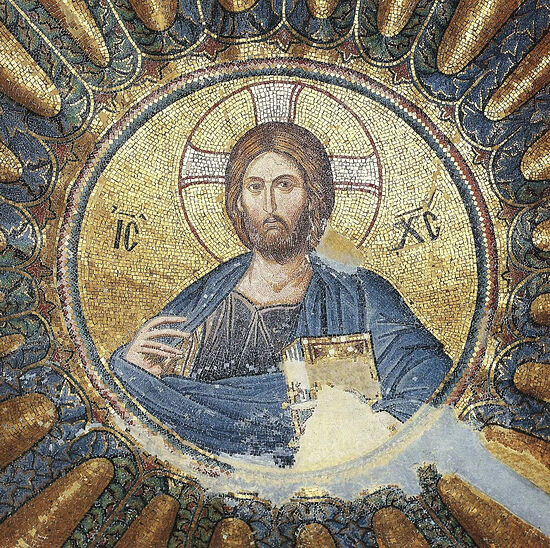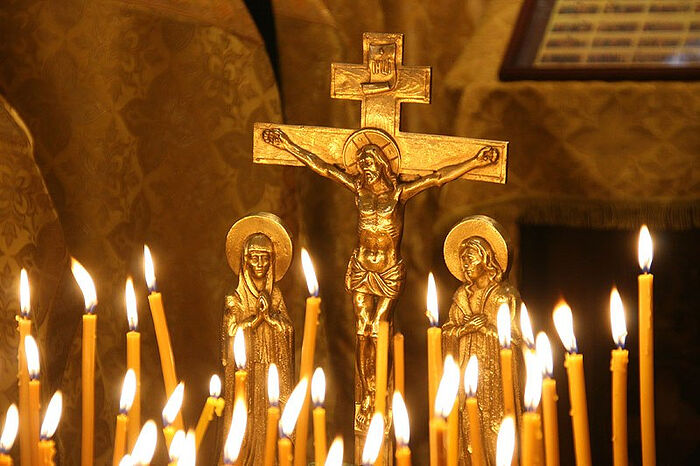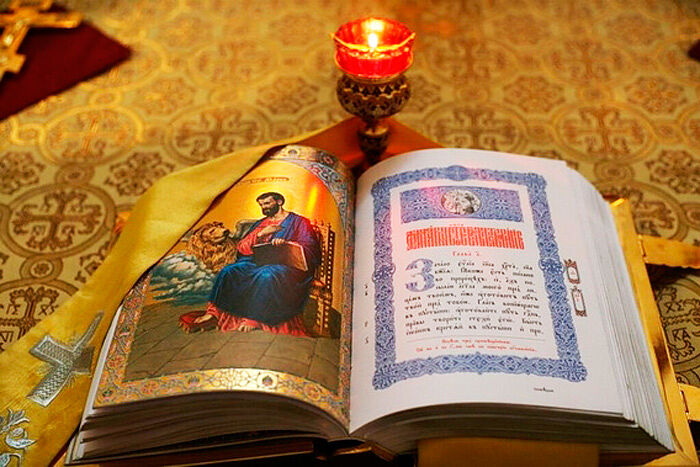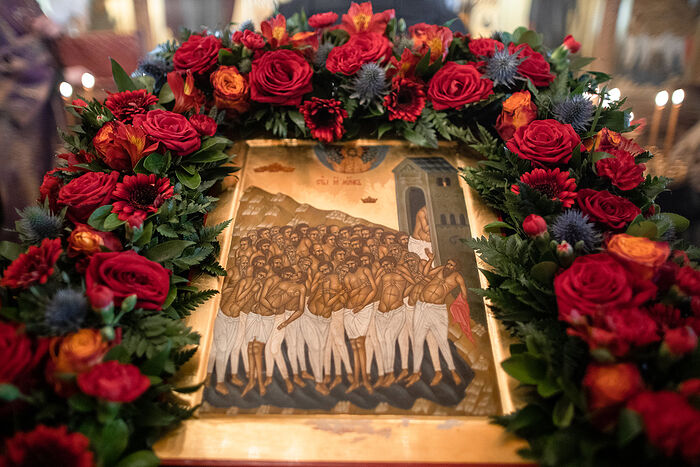 Photo: polotnos.com
Photo: polotnos.com
In the name of the Father and of the Son and of the Holy Spirit!
On the first Sunday of Great Lent, the holy Church allows us—all of us who have passed the first week in repentance—to unite in the knowledge of our affinity with the first man, Adam, in the consciousness that each of us bears the image of God’s ineffable gory, although covered by the sores of transgressions; and in a repentant cry to the Lord, “Have mercy on me, O God, have mercy on me,” which allows us, the faithful, to come now to great joy—for today is a day of joy, the day of the Triumph of Orthodoxy.
It is not without reason that this week begins with such a day.
If we, the faithful, were always in the state of the first Adam, weeping, repenting, and crying out: “Have mercy on me, the fallen one;” if we were in a state of near despair with him, with only a distant hope that someday the seed of a woman will bruise the head of the serpent (cf. Gen. 3:15), then we’d still be in the Old Testament. But we are in the New Testament.
The holy Church has the  The Sunday of the Triumph of Orthodoxy
The Sunday of the Triumph of Orthodoxy
“>Triumph of Orthodoxy in the second week to remind us that we have this promise already fulfilled, that we’re already in the New Testament, that although we’re covered with the wounds of sins like the first man, the Savior was on earth. Not only was He on earth, but He also left us His Body—the Church—and glorifying Him, celebrating His coming, we confess Him in Orthodox manner.
But why is this timed to coincide with the celebration of icon veneration, and why were all the stichera that we sang yesterday about the veneration of icons?
Why on this Sunday, when it was necessary to give us joy, did the holy Church give it to us through icons, through the celebration of iconodulia?
Why do we glorify the most-pure image of the Savior?
The struggle for the icon is the struggle for the reality of Christ, for the fact that He truly came to earth and lived on it not only as God, but also as man. He wasn’t a phantom, as the Holy Fathers say, but was truly in the flesh. Therefore, the struggle for iconodulia continued for an entire century and tore the Church apart into irreconcilable enemies, into those who defended icon veneration and those who rebelled against it.
And now it’s over!
What exactly is an attack on icons?
It is an attack on the existence of Christ. This is an essential point for Christianity. If we turn to the Holy Fathers who fought for icons, we’ll feel a kinship with their age.
When  Venerable Theodore the Confessor the Abbot of the StudionSaint Theodore the Confessor, Abbot of the Studion was born in the year 758 at Constantinople into a family of the imperial tax-collector Photinus and his spouse Theoctiste, both pious Christians.
Venerable Theodore the Confessor the Abbot of the StudionSaint Theodore the Confessor, Abbot of the Studion was born in the year 758 at Constantinople into a family of the imperial tax-collector Photinus and his spouse Theoctiste, both pious Christians.
“>St. Theodore the Studite wrote against the iconoclasts, he pointed out that had God not been on earth as man, it would be impossible to depict Him—that is, to paint Him. But now there is no reason why He shouldn’t be depicted.
So let him (an iconoclast), in speaking out, teach what physical basis he has and what the reason is for such undepictability. Did not Christ take on our image? Was not His Body made up of bones? Were not His pupils shielded by eyelids and eyebrows? Were not His ears made with winding canals? Were not His nostrils adapted for smelling? Was He not endowed with ruddy cheeks? Was it not with His lips and tongue and teeth that He spoke and ate and drank? Was He not built with joints of the shoulders, elbows, and hands? Did He not naturally have a chest and spine, shins and feet? Did He not move when walking—up, down, in, out, right, left, and around? Did He not have hair on His head and did He not clothe His entire body with a robe? If He undoubtedly exhibited this, then the physical form serves as a true image of Him, and it is audacity to assert that Christ is undepictable.1
“If Christ is man,” concludes St. Theodore, “then it’s obvious that He can be depicted on an icon, for the first property of man is to be depicted; if He’s not depicted, then He’s not man, but fleshless, and Christ has not even come yet, as the Jews prattle.”2
The Holy Father concludes, as we do now, that the struggle for the icon is a struggle for Christ, for the Savior, for Him Who was not only foretold to the first man, when it was said that there would come a time when the Seed of a woman would crush the head of the serpent. And that time came. Being God, He was also perfect man, and as man, He turns from indescribable to describable, from uncontainable to containable; and from great He becomes at the same time small.
Thus the holy Church has given us the Triumph of Orthodoxy—the restoration of iconodulia, the restoration of the authentic teaching of Christ, for the Lord came to earth as God, but also as man in the flesh.
And in our times, when some try to prove that Christ didn’t exist, they first of all attack the icons, the veneration of icons, despite their being favorable towards paintings and art in general. The whole point is that they want to deny Christ, to reject Him, and therefore they’re against icons.
We often hear: “You make yourselves a host of gods and worship them.” Is that true?
If we believe that Christ delivered us from the state of Adam, weeping over Paradise lost, and leads us into the holy Church; if He accepts us as prodigal children and not only slaughters the lamb, but gives us His Body, adorned in the first garment of incorruption and holiness—then on this day of the Triumph of Orthodoxy we must give an account of why we venerate icons.
“The honor rendered to an icon ascends to the prototype,” says St. Basil the Great and the stichera that we heard yesterday.
What does that mean?
It means that if we have some depiction of the Lord, then this image, His countenance, gives us the chance to relate to Him, the Prototype, just as a portrait of someone prompts us to ascend to the person depicted. Everyone knows that if we have some photo, we’ll say: “This is my mother; this is my father,” and no one ever has any doubt, although everyone knows it’s cardboard, paper, a photographic image, because through this image we ascend to the prototype, which is precisely what we see in the photograph.
Similarly with regard to icons, through an image of Christ we ascend to Him: “The honor rendered to an icon ascends to the prototype.”
Those who venerate the holy icons, should know the definition of the Seventh Ecumenical Council, the memory of which we’re celebrating now, for it confirmed the true teaching about icons:
We, therefore, following the royal pathway and the divinely inspired authority of our Holy Fathers and the traditions of the Catholic Church (for, as we all know, the Holy Spirit indwells her), define with all certitude and accuracy that just as the figure of the precious and life-giving Cross, so also the venerable and holy images, as well in painting and mosaic as of other fit materials, should be set forth in the holy churches of God, and on the sacred vessels and on the vestments and on hangings and in pictures both in houses and by the wayside, to wit, the figure of our Lord God and Savior Jesus Christ, of our spotless Lady, the Mother of God, of the honorable angels, of all saints and of all pious people. For by so much more frequently as they are seen in artistic representation, by so much more readily are men lifted up to the memory of their prototypes, and to a longing after them; and to these should be given due salutation and honorable reverence, not indeed that true worship of faith which pertains alone to the Divine nature.3
True worship is not rendered to an icon but to God, while an icon is what is necessary for us as the means through which we elevate ourselves to the Prototype. This is what the Seventh Ecumenical Council teaches.
Those of us who have passed through the first week of Great Lent but have no repentance or tears should reproach ourselves for this. It is necessary for us to join those who had these tears of repentance, those ascetics and especially the author of the Great Canon and the  Venerable Mary of EgyptCovered by the cloak, the ascetic turned to Zosimas: “Why do you want to speak with me, a sinful woman? What did you wish to learn from me, you who have not shrunk from such great labors?”
Venerable Mary of EgyptCovered by the cloak, the ascetic turned to Zosimas: “Why do you want to speak with me, a sinful woman? What did you wish to learn from me, you who have not shrunk from such great labors?”
“>Venerable Mother Mary of Egypt.
We do not have the despair as in the Old Testament, but neither do we have the courage that St. Andrew of Crete speaks of: “I have reviewed as examples for you, O my soul, all the figures of the Old Testament. Learn to imitate the deeds of those who in righteousness loved their God, and flee from the sins of the wicked!”
They did not yet have the joy of the good news of the birth of Christ. But we not only have it and know it—we have now received the Most Pure Body and Blood into ourselves. We not only know as a parable that the Lord will receive us, but we also know that we are now received by Him again; we have again received the garment of incorruption. And all this is so because Christ was and is in the Church—and hence our faith in icons, in that it’s possible to depict Him, unfathomable and ineffable.
Today’s joy should lead us to the realization that we are a new creature in Christ: “As many as have been baptized into Christ have put on Christ.”
Let us remember that the fast hasn’t ended but is just beginning; and having passed through the repentance of Adam, having been clothed in the garment of incorruption, let us go further along the path revealed to us by the holy Church, through the radiance of Taboric light, to the joy of life in the Lord.
Amen.
 Photo: tagileparhiya.ru
Photo: tagileparhiya.ru 
 The Sunday of the Triumph of Orthodoxy
The Sunday of the Triumph of Orthodoxy Venerable Mary of EgyptCovered by the cloak, the ascetic turned to Zosimas: “Why do you want to speak with me, a sinful woman? What did you wish to learn from me, you who have not shrunk from such great labors?”
Venerable Mary of EgyptCovered by the cloak, the ascetic turned to Zosimas: “Why do you want to speak with me, a sinful woman? What did you wish to learn from me, you who have not shrunk from such great labors?”
